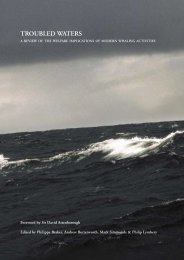norwegian use of whales: past, present and future trends - WSPA
norwegian use of whales: past, present and future trends - WSPA
norwegian use of whales: past, present and future trends - WSPA
Create successful ePaper yourself
Turn your PDF publications into a flip-book with our unique Google optimized e-Paper software.
Norwegian Use <strong>of</strong> Whales<br />
Buyers <strong>and</strong> wholesalers are hit by low dem<strong>and</strong>. Åge Eriksen, owner <strong>and</strong> manager <strong>of</strong><br />
Hopen Fisk AS, one <strong>of</strong> Norway’s largest purchasers/ buyers <strong>of</strong> whale, stated to ABC<br />
News in August 2009 that “I think that the entire whale market could disappear.” 56<br />
He has also stated that “overall, we are talking about small volumes <strong>and</strong> little<br />
money. It is not particularly economical, <strong>and</strong> it is not pr<strong>of</strong>itable to continue.” 57<br />
Another company managed by Åge Eriksen, Hopen Fisk & Sild AS, declared<br />
bankruptcy in 2008, <strong>and</strong> all <strong>of</strong> the property <strong>and</strong> activities were taken over by<br />
Hopen Fisk AS <strong>and</strong> Eiendommen Hopen AS. 58<br />
Another major buyer, Ellingsen Seafood in Skrova, is scaling down production <strong>of</strong><br />
whale meat. In <strong>past</strong> years Ellingsen has taken up to 30% <strong>of</strong> <strong>whales</strong> hunted. In 2005<br />
the company launched several new whale meat products, including the<br />
‘L<strong>of</strong>otburger’ (half minke whale <strong>and</strong> half pork), aiming to market whale to a new<br />
generation <strong>of</strong> consumers. 59 Subsequently, in March 2008, the Chairman, Ulf<br />
Ellingsen, expressed his fears that the hunt would “slowly but surely dry up”,<br />
stating that “Whale hunting is in a downward spiral” 60 <strong>and</strong> announcing that it was<br />
considering stopping sales <strong>of</strong> whale meat, since “pr<strong>of</strong>itability is too little <strong>and</strong> it is<br />
difficult to get hold <strong>of</strong> employees for the short season. The industry is now at a<br />
crossroads <strong>and</strong> for us, salmon (farmed) is more important than whale”. 61,62<br />
The Norwegian Fishermen’s Sales Organisation reported that 10 buyers were<br />
operating in their area in 2008, purchasing quantities <strong>of</strong> between 5 <strong>and</strong> 106 tonnes<br />
<strong>of</strong> whale meat: buyers that previously had purchased about 200 tonnes <strong>of</strong> whale<br />
meat a year reduced the quantity <strong>of</strong> their purchases to 100 tonnes or less. 63 The<br />
Norwegian Fishermen’s Sales Organisation explains that sales were difficult due to<br />
the fact that there were fewer buyers, <strong>and</strong> reduced purchases; buyers had no<br />
desire to only “purchase for storage”. The 2009 annual report does not give figures<br />
for the number <strong>of</strong> buyers. In 2010 there were 9 processors <strong>of</strong> whale meat in<br />
Norwegian Fishermen’s Sales Organisation’s district. This figure includes both those<br />
that buy <strong>and</strong> process whale meat <strong>and</strong> the hunters that process their own catch.<br />
There were 3 processors outside <strong>of</strong> Norwegian Fishermen’s Sales Organisation’s<br />
district – 1 in Sunnmøre og Romsdal Fiskesalslag <strong>and</strong> 2 in Vest-Norges Fiskesalslag. 64<br />
The lack <strong>of</strong> dem<strong>and</strong> from buyers <strong>and</strong> wholesalers impacts on whalers, as recognised<br />
by Per Rol<strong>and</strong>sen <strong>of</strong> the Norwegian Fishermen’s Sales Organisation, noting that<br />
“the buyers are fewer than before, <strong>and</strong> those that are buying, buy less. Therefore<br />
earnings are low beca<strong>use</strong> <strong>of</strong> the difficulty trading the whale meat.” 65<br />
Dem<strong>and</strong> conditions have led to additional steps to even out the supply <strong>of</strong> whale<br />
meat through the season, <strong>and</strong> to prevent excess supply. Having noted that the<br />
majority <strong>of</strong> whale meat was coming in late in the season, <strong>and</strong> was difficult to sell<br />
<strong>of</strong>f in large quantities, in 2006 <strong>and</strong> 2008 (but not 2007) they decided to encourage<br />
early-season hunting by <strong>of</strong>fering higher minimum prices in the beginning <strong>of</strong> the<br />
season. On 31 March 2008, Circular nr. 8/2008 was issued to whale hunters <strong>and</strong><br />
registered buyers. It dealt with the regulation <strong>of</strong> whale hunting for 2008 <strong>and</strong><br />
stated that “interest in the purchase <strong>of</strong> whale <strong>and</strong> whale products is limited <strong>and</strong><br />
can lead to problems with the turnover <strong>of</strong> caught <strong>whales</strong>” <strong>and</strong> that “large catches<br />
are difficult to turn over”.<br />
eftec 35 April 2011

















